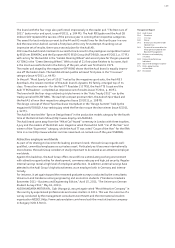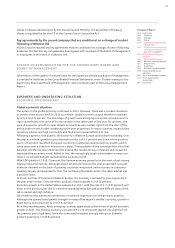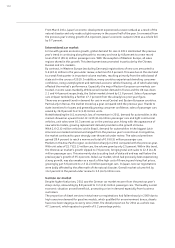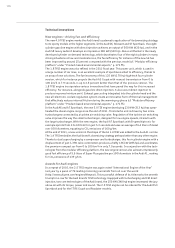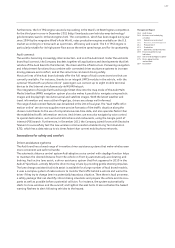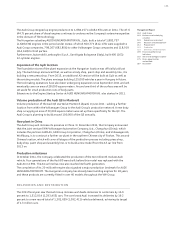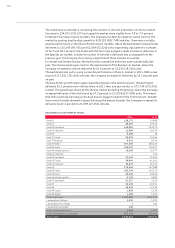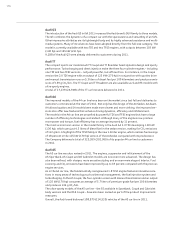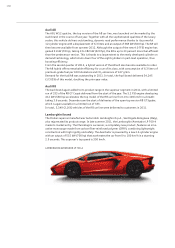Audi 2011 Annual Report Download - page 151
Download and view the complete annual report
Please find page 151 of the 2011 Audi annual report below. You can navigate through the pages in the report by either clicking on the pages listed below, or by using the keyword search tool below to find specific information within the annual report.
148
The Audi brand’s driver assistance systems were further improved and interconnected in the past
fiscal year. The Company pursues a philosophy of designing systems that optimally support
customers without taking over from them. For all the growing importance of driver assistance
systems, the driver remains in charge and responsible for the vehicle.
The Company is also working intensively on the development of new systems. For instance, in
future a traffic jam assistant will help the driver to negotiate slow-moving traffic by automatically
accelerating and braking, as well as by providing steering assistance.
New Audi models awarded five stars in Euro NCAP crash test
In addition to the new Audi A6, which was awarded the top five-star rating by the renowned
European driving safety agency “European New Car Assessment Programme” (Euro NCAP),
the Audi Q3 compact premium SUV achieved top marks for passive crash safety
(http://www.euroncap.com/results/audi.aspx).
The models scored especially well for adult occupant protection in a front, rear and side collision
and in the categories child safety and pedestrian protection.
The Audi brand has given its models a further safety boost by including the ESP stabilization
program as standard, alongside the optional driver assistance systems.
Electric mobility
Electric mobility at Audi
Alongside efficient combustion engines, hybrid drive systems and other alternative forms of drive
technology such as gas-powered vehicles, electric mobility is a key cornerstone of the Audi Group’s
technology strategy (cf. “Future mobility” under “Product-based environmental aspects,”
p. 170 f.). Amid its quest to identify the future shape of mobility, the Company pursues the broad-
based policy of coordinating all systems and components as far as possible in order to exploit
the full potential of electric mobility.
The interdisciplinary project house e-performance was launched back in 2009 to pool the skills of
all development areas and devise strategic solutions to the questions posed by electric mobility.
This Audi think-tank maintains an ongoing dialog with external experts such as universities and
research institutes. The new development and test center for electrified drivetrains was opened
in 2010. Its cutting-edge infrastructure permits a highly integrated working approach and pro-
vides a good basis on which to optimize the key technologies of drives, batteries and power
electronics, leading to the practical testing of the entire drivetrain.
AUDI AG is also actively involved in the “National Platform for Electric Mobility” initiative launched
in May 2010. This is an advisory body set up by the German government with the goal of making
Germany not just the lead market, but also the leading supplier of electric mobility by 2020.
The topic of electric mobility was once again a priority research area in fiscal 2011. For example,
the pilot project “Munich Model Region for Electric Mobility” supported by the German Federal
Ministry of Transport, Building and Urban Development (BMVBS) got off the ground. This fleet
test, involving a total of 20 Audi A1 e-tron cars, is intended to explore customers’ mobility be-
havior in greater depth when driving electric vehicles. The all-electric A1 e-tron develops an
output of 75 kW (102 hp). If necessary, a compact combustion engine known as a range extend-
er recharges the battery, increasing its range to as much as 250 kilometers. For the first 50
kilometers the Audi A1 e-tron, which is designed specifically for urban use, can run with zero
local emissions. Other prestigious partners are involved in the pilot project. E.ON and Munich’s
public utility company Stadtwerke München are in charge of developing and operating the
charging infrastructure – E.ON mainly in outlying areas and Stadtwerke München in the Bavarian
capital itself. All charging points supply renewable energy. The Technical University of Munich is
monitoring and evaluating mobility behavior over the course of the project.



